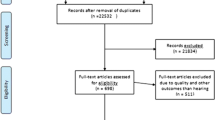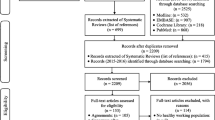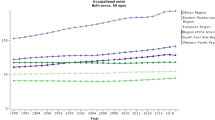Abstract
The aim of the present study is to examine the relationship between the working conditions of employees in the food industry and blood pressure. An epidemiological survey was conducted between 1987 and 1988 in 17 poultry slaughterhouses and 6 canneries in the French regions of ‘Bretagne’ and ‘Pays de Loire’. One thousand, four hundred and seventy-four workers were included in the study. Data was collected in the course of the medical visit organized annually for employees. Mean diastolic (DBP) and systolic blood pressure (SBP) were analyzed separately for male and female workers. The results indicate a significant relationship between blood pressure, and age and obesity. Amongst the various features of working condition studies, loud noise and the number of work breaks were found to be associated with heightened mean values of DBP or SBP in men only. Type and size of the factory was found to be associated with blood pressure readings for both sexes. A number of working conditions giving rise to heightened mental strain were found to be related to a lowering in mean blood pressure: for example, irregular work finishing times for men and production-line work for women. A discussion of these results reveals the complexity of the relationships which exist between physical and environmental factors in this type of setting and blood pressure of employees.
Similar content being viewed by others
References
Fouriaud C, Jacquinet-Salord MC, Degoulet P, Aim é F, Lang T, Laprugne J, Main J, Oeconomos J, Phalente J, Prades A. Influence of socioprofessional conditions on blood pressure levels and hypertension control: Epidemiologic study of 6665 subjects in the Paris district. Am J Epidemiol 1984; 120; 72–86.
Andrén L, Hansson L, Eggertsen R, Hedner T, Karlberg BE. Circulatory effects of noise. Acta Med Scand 1983; 213: 31–35.
Jonsson A, Hansson L. Prolonged exposure to a stressful stimulus (noise) as a cause of raised blood-pressure in man. Lancet 1977 (i): 86–87.
Talbott E, Helmkamp J, Matthews K, Kuller L, Cottington E, Redmond G. Occupational noise exposure, noise-induced hearing loss, and the epidemiology of high blood pressure. Am J Epidemiol 1985; 121: 501–514.
Tarter SK, Robins TG. Chronic noise exposure, high-frequency hearing loss, and hypertension among automotive assembly workers. J Occup Med 1990; 32: 685–689.
Lang T, Fouriaud C, Degoulet P. Exposition professionnelle au bruit, déficit auditif et hypertension artérielle. Rev Epidemiol Santé Publique 1986; 34: 318–323.
Kloetzel K, Etelvino de Andrade A, Falleiros J, Cota Pacheco J. Relationship between hypertension and prolonged exposure to heat. J Occup Med 1973; 15: 878–880.
Mustacchi P. Arterial hypertension and the work environment: Some considerations affecting its compensability. J Occup Med 1976; 18: 561–566.
Estryn-Behar M, Lang T, Peigne E, Melonio G, Louet M. Epidémiologie des facteurs de risque cardiovasculaires chez 1505 femmes travaillant en milieu hospitalier. Presse Med 1989; 18: 1960–1964.
Hauenstein LS, Kasl SV, Harburg E. Work status, work satisfaction, and blood pressure among married black and white women. Psychol Women Q 1977; 1: 334–349.
Burton BT, Foster WR, Hirsch J, Van Itallie TB. Health implications of obesity: An NIH consensus development conference. Int J Obes 1985; 9: 155–169.
Saurel-Cubizolles MJ, Bourgine M, Touranchet A, Verger C, Kaminski M. Douleurs périarticulaires des membres supérieures et conditions de travail dans les abattoirs de volatile et les conserveries. Arch Mal Professionnelles 1992; 53: 474–476.
Messing K, Saurel-Cubizolles MJ, Bourgine M, Kaminski M. Menstrual cycles characteristics and working conditions in poultry slaughterhouses and canneries. Scand J Work Environ Health 1992; 18: 302–309.
Björntrop P. Hypertension and exercise. Hypertension 1982; 4 (suppl III): 56–59.
Schnall PL, Pieper C, Schwartz JE, Karasek RA, Schlussel Y, Devereux RB, Ganau A, Alderman M, Warren K, Pickering TG. The relation between ‘job strain’, workplace distolic blood pressure, and left ventricular mass index. JAMA 1990; 263: 1929–1935.
Winkleby MA, Raglang DR, Syme SL. Self-reported stressors and hypertension: Evidence of an inverse association. Am J Epidemiol 1988; 127: 124–134.
Zimmerman MK, Hartley WS. High blood pressure among employed women: A multifactor discriminant analysis. J Health Soc Behav 1982; 23: 205–220.
Pilgrim JA, Stansfeld S, Marmot M. Low blood pressure, low mood? Br Med J 1992; 304: 75–78.
Author information
Authors and Affiliations
Rights and permissions
About this article
Cite this article
Ledésert, B., Saurel-Cubizolles, M.J., Bourgine, M. et al. Risk factors for high blood pressure among workers in French poultry slaughterhouses and canneries. Eur J Epidemiol 10, 609–620 (1994). https://doi.org/10.1007/BF01719581
Accepted:
Issue Date:
DOI: https://doi.org/10.1007/BF01719581




